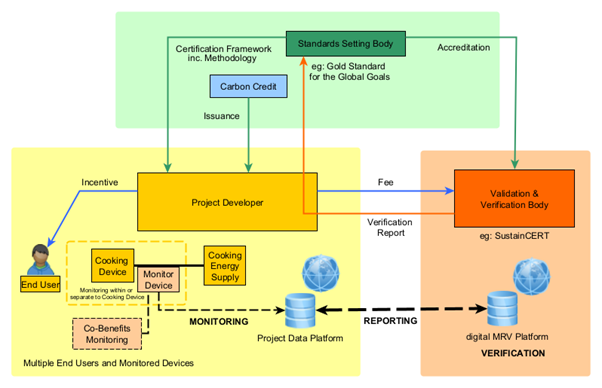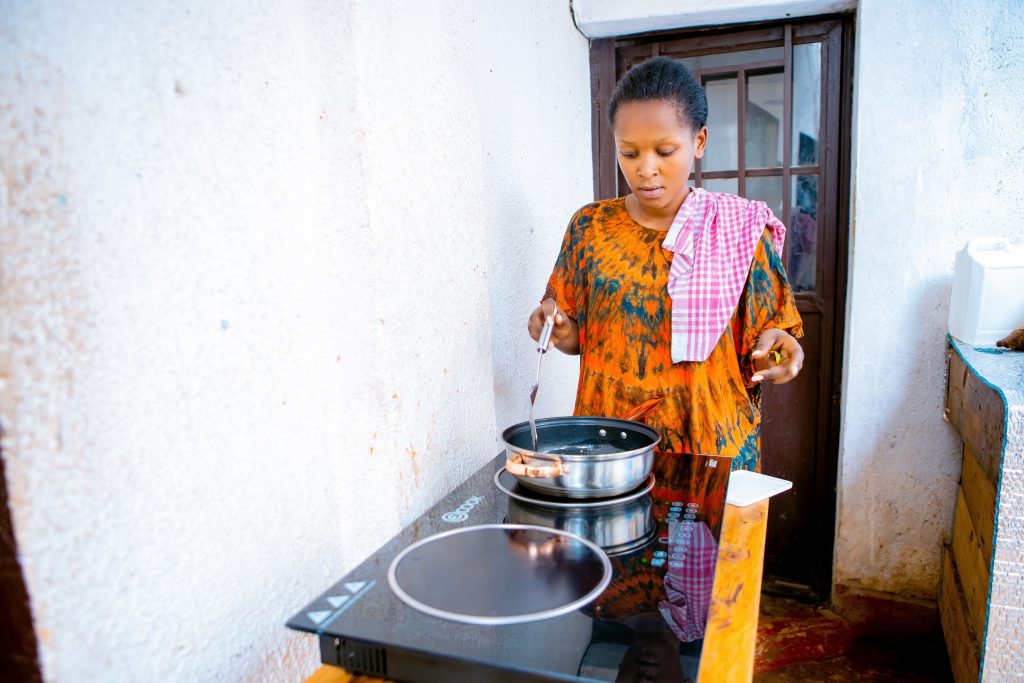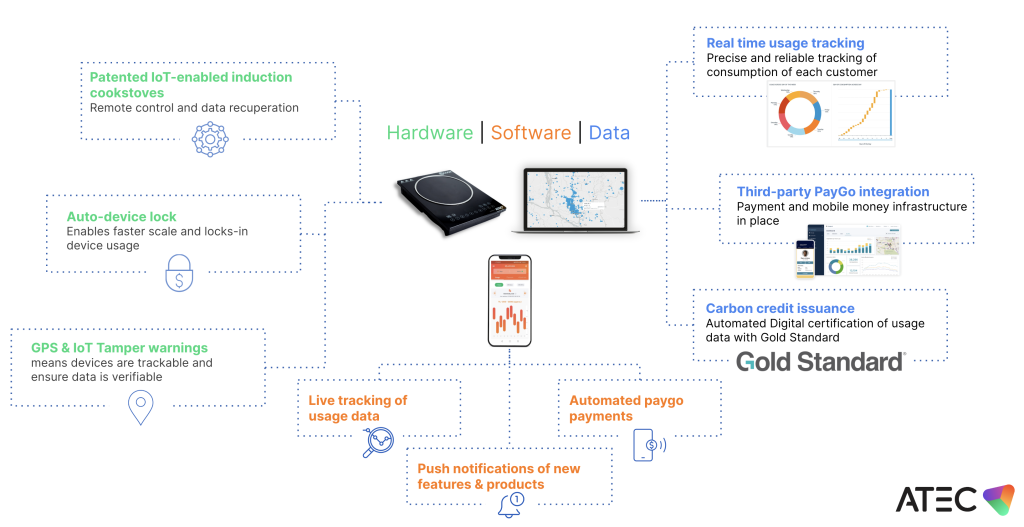
- Date
- 6th February 2024
- Categories
- Carbon Credit, Clean Cooking, Electric Cooking
By Professor Matt Leach and Malcolm Bricknell (Modern Energy Cooking Services Programme, Loughborough University).
Carbon Credits have become increasingly important as a source of funding for clean cooking projects in developing countries. However, Carbon Credit certification procedures have been complex and challenging to execute, particularly for smaller project developers. At the same time the integrity of some traditional certification methodologies based around surveys has recently been challenged, most notably by researchers from University of Berkeley.
The increasing use of digital technology in Modern Energy Cooking (MEC), coupled with advances in the measurement of fuel use, has allowed for new methodologies for calculating carbon emission reductions with greater accuracy. These can achieve cost savings for monitoring, reporting and verification (MRV) and also promote integrity and transparency by using hard data rather than surveys (which are more open to interpretation and behavioural bias).
In 2020, Modern Energy Cooking Services (MECS) appointed Climate Care (now Climate Impact Partners) to develop a digital methodology for calculating emission reductions for electric and other clean cooking appliances that can be metered or measured and to negotiate its acceptance by a leading certification agency- Gold Standard (GS). The new methodology which they developed quantifies GHG impacts through the direct metering or measurement of electricity or fuel use. It applies to almost all MEC appliances including LPG, electric, biogas, and bioethanol cookstoves. In October 2021, the Gold Standard approved the new methodology, which came into effect in January 2022 as: “Methodology for Metered & Measured Energy Cooking Devices v1.0” (MMMECDv1.0).
To establish its viability, Climate Impact Partners and MECS have been supporting ATEC Global to certify a project with Gold Standard using the new methodology. In December 2023, SustainCert (on behalf of Gold Standard) validated the ATEC project (involving induction cookstoves in Bangladesh and Cambodia), thereby effectively demonstrating the viability of the new methodology.
In the course of this work, MECS and some other parties realized that a number of changes were required to make the new standard work effectively for the most efficient electrical devices. MECS submitted a paper to Gold Standard, together with relevant research, proposing an alternative calculation option and in October 2022, Gold Standard announced a revision to the methodology, MMMECDv1.1. The revised standard introduced alternative calculation options that will allow the high performance of the most energy efficient devices (e.g. Electric Pressure Cookers) to be well represented. (A version 1.2 was released in December 2022 following a further minor revision requested by MECS). As for all methodologies, further refinements are likely over time, and MECS is engaged with interested developers in ongoing review.
VERRA, which operates the Voluntary Carbon Standard, has recently produced a new draft Methodology for Improved Cookstoves and Other Distributed Thermal Energy Generation Unitswhich allows for a very similar DMRV approach to that of Gold Standard. Consequently, it is likely that these methodologies will become well established in both the Voluntary Carbon Market and Compliance markets and offer attractive possibilities for Modern Energy Cooking projects to access carbon credits.

The advantages of the Metered Methodologies were explicitly recognised in the recent Berkeley Report which mentions “Our results are a call to action to overhaul offset programme design and the dominance of improved but not WHO-defined clean stoves. Prioritizing metered fuel switch projects and accurately quantifying their emission reductions would progress climate, energy, and health SDGs. Our analysis indicates that these stoves currently offer the least over-credited credits and have the greatest abatement potential and health benefit. Further, they are often the most challenging for users to sustainably use, given the need for continuous fuel purchases, and thus are the cookstove project types that could most benefit from carbon finance. Our results further support Gill-Wiehl and Kammen’s call for the VCM to exclusively fund WHO-defined clean stoves and highlight the lost opportunity to use cookstove offsets to accelerate access to the cleanest stoves/fuels. Quality cookstove offsets could sustainably, instead of performatively, improve the health of people and the planet.”
At the same time some discrepancies in the Metered Methodologies were identified by the Berkeley team together with recommendations on the issues requiring to be addressed to correct these. It is encouraging that influential market players, including MECS, are collaborating to further refine the methodologies in order to make them robust and transparent in order to restore the confidence of carbon credit buyers. As Ben Jeffreys the CEO of ATEC put it “ensuring ‘a ton of emission reductions is actually a ton’ is critical if we are to reach the full potential of the cookstove carbon-market sector”.

There are different technical methods for meeting the requirements for measuring cooking device usage for the MMMECD and similar, and it is apparent that there is rapid ongoing technological innovation in the sector. MECS has therefore commissioned a report outlining the landscape of digital MRV requirements and related solutions which will be published soon and made available on the MECS website. The report will be included in the section of the MECS website covering carbon credits. This website also includes a range of reports produced by Climate Focus on behalf of MECS which provide an overview of the carbon credit project development process for cooking projects and describe in detail different aspects of the Voluntary Carbon Markets.
Equitable Revenue Sharing
The issues of transparency and equitable revenue sharing have become increasingly important in the carbon credit markets. Stories of projects with little benefit flowing to local households are very disturbing for offset buyers. New digital technology in automated data generation and PAYGO payments allows for the direct reflow of finance from carbon revenues to local households to be made cheaply, accurately and transparently (essentially via a reverse PAYGO payment or an offsetting credit). ATEC has been pioneering this approach, with some support from MECS, under its “Cook-to-Earn”model and Fair Climate Fund has worked with ATEC to show how the advantages of this approach can be enhanced further.

Co-benefits SDG Impacts
Since 2017, the Gold Standard has required projects to report verified contributions to at least two SDGs in addition to carbon emission savings. One reason for the popularity of the GS Verified Emission Reductions (VERs) is the well-developed methodology for certifying other non-carbon Sustainable Development Goal (SDG) impacts, so allowing higher prices to be achieved for their VERs (carbon credits). This is particularly important for cooking projects with their strong potential to generate other SDG impacts (co-benefits) in addition to carbon reduction.
Most cooking projects to date have measured these benefits rather superficially at the activity level rather than at the outcome and impact levels due to the cost and complexity of analysing these impacts in more detail and the limited levels of information required to date by offset buyers. New initiatives including requirements from the Integrity Council for the Voluntary Carbon Market (ICVCM) will impose higher standards on project developers, whilst corporate buyers are becoming more selective in their requirements to meet both their Environmental, Social and Governance (ESG) goals and their climate targets.
A major obstacle to better reporting of co-benefits has been the administrative costs of measuring and demonstrating these SDG impacts. Digital technology can play an important role in reducing costs and enabling reporting at a wholly different level to earlier practices.
Some SDG impacts should be relatively straightforward to demonstrate using quantitative usage data- for example in calculating time saved for women in cooking and fuel collection, averted deforestation, reduction in SLCPs etc.
Digital technology could also hold the key to unlocking the cost-effective calculation of some very important but very hard to demonstrate SDG impacts. This may apply around accurate measurements of health impacts. While cooking projects have been linked to reduced air pollution in many studies, the resulting health outcomes have been difficult to quantify. Estimation of averted DALYs, representing the number of years of healthy life made possible by a given intervention is the most commonly used metric. The quantification and certification of Gold Standard certified aDALYs is based on the Household Air Pollution Intervention Tool (HAPIT) developed by the Berkeley Air Monitoring Group (or a variant of this). This methodology has been used very rarely in practice for cooking projects due to the high costs of measuring indoor air quality (including personal exposures) in the baseline and project scenarios.
It is true that further research may also be required to conclusively demonstrate the links between cooking energy use, HAP and personal exposure together with related health impacts, however there are promising opportunities for this work to be realised based on digital methods. Currently, using light scattering monitors periodically calibrated with Gravimetric testing (or full Gravimetric testing) is the only approach accepted by GS. However more recent technology for optical measurement with remote monitoring and data logging/analysis could be reliable enough to replace expensive and complex Gravimetric tests. This could then allow a much cheaper approach to calculating aDALYs and the opportunity to integrate this data into a wider digital data platform built around meeting the GS reporting system required to claim VERs.
Digital technology offers an outstanding opportunity to transform Impact Finance for Modern Energy Cooking projects by reducing cost and increasing the accuracy and integrity of data. This could in turn catalyse urgently needed funding to accelerate the transition to Modern Energy Cooking, as almost all donors now require accurate and cost-effective reporting of impacts as a condition of providing their support. Restoring confidence in MEC carbon credits through using the correct hard data generated by digital technology is a crucial first step. Cooperation by different parties to achieve this is going to be very important.

Featured Image: Cooking on Induction Stove. Copyright of ATEC.